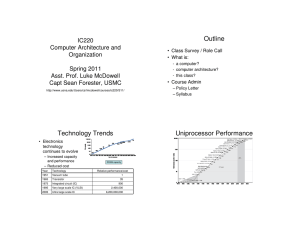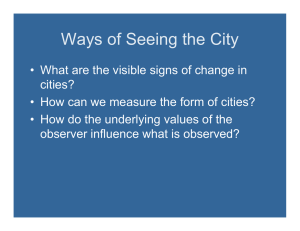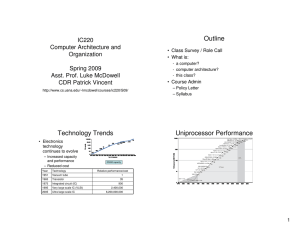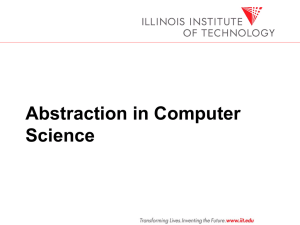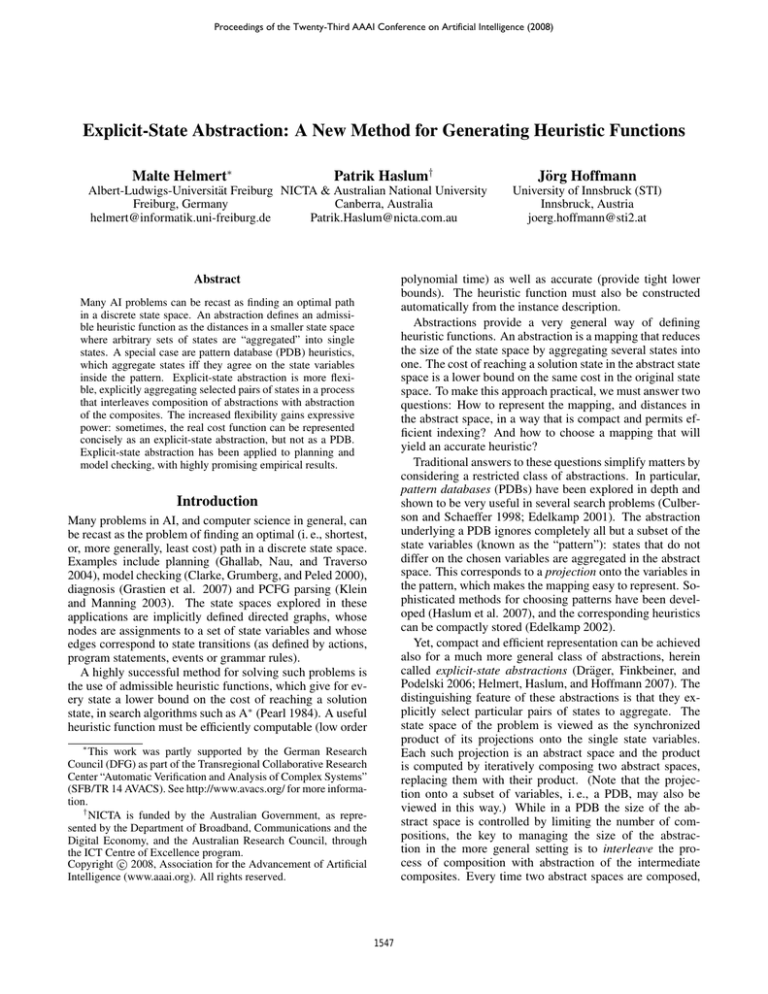
Proceedings of the Twenty-Third AAAI Conference on Artificial Intelligence (2008)
Explicit-State Abstraction: A New Method for Generating Heuristic Functions
Malte Helmert∗
Patrik Haslum†
Albert-Ludwigs-Universität Freiburg NICTA & Australian National University
Freiburg, Germany
Canberra, Australia
helmert@informatik.uni-freiburg.de
Patrik.Haslum@nicta.com.au
Abstract
Jörg Hoffmann
University of Innsbruck (STI)
Innsbruck, Austria
joerg.hoffmann@sti2.at
polynomial time) as well as accurate (provide tight lower
bounds). The heuristic function must also be constructed
automatically from the instance description.
Abstractions provide a very general way of defining
heuristic functions. An abstraction is a mapping that reduces
the size of the state space by aggregating several states into
one. The cost of reaching a solution state in the abstract state
space is a lower bound on the same cost in the original state
space. To make this approach practical, we must answer two
questions: How to represent the mapping, and distances in
the abstract space, in a way that is compact and permits efficient indexing? And how to choose a mapping that will
yield an accurate heuristic?
Traditional answers to these questions simplify matters by
considering a restricted class of abstractions. In particular,
pattern databases (PDBs) have been explored in depth and
shown to be very useful in several search problems (Culberson and Schaeffer 1998; Edelkamp 2001). The abstraction
underlying a PDB ignores completely all but a subset of the
state variables (known as the “pattern”): states that do not
differ on the chosen variables are aggregated in the abstract
space. This corresponds to a projection onto the variables in
the pattern, which makes the mapping easy to represent. Sophisticated methods for choosing patterns have been developed (Haslum et al. 2007), and the corresponding heuristics
can be compactly stored (Edelkamp 2002).
Yet, compact and efficient representation can be achieved
also for a much more general class of abstractions, herein
called explicit-state abstractions (Dräger, Finkbeiner, and
Podelski 2006; Helmert, Haslum, and Hoffmann 2007). The
distinguishing feature of these abstractions is that they explicitly select particular pairs of states to aggregate. The
state space of the problem is viewed as the synchronized
product of its projections onto the single state variables.
Each such projection is an abstract space and the product
is computed by iteratively composing two abstract spaces,
replacing them with their product. (Note that the projection onto a subset of variables, i. e., a PDB, may also be
viewed in this way.) While in a PDB the size of the abstract space is controlled by limiting the number of compositions, the key to managing the size of the abstraction in the more general setting is to interleave the process of composition with abstraction of the intermediate
composites. Every time two abstract spaces are composed,
Many AI problems can be recast as finding an optimal path
in a discrete state space. An abstraction defines an admissible heuristic function as the distances in a smaller state space
where arbitrary sets of states are “aggregated” into single
states. A special case are pattern database (PDB) heuristics,
which aggregate states iff they agree on the state variables
inside the pattern. Explicit-state abstraction is more flexible, explicitly aggregating selected pairs of states in a process
that interleaves composition of abstractions with abstraction
of the composites. The increased flexibility gains expressive
power: sometimes, the real cost function can be represented
concisely as an explicit-state abstraction, but not as a PDB.
Explicit-state abstraction has been applied to planning and
model checking, with highly promising empirical results.
Introduction
Many problems in AI, and computer science in general, can
be recast as the problem of finding an optimal (i. e., shortest,
or, more generally, least cost) path in a discrete state space.
Examples include planning (Ghallab, Nau, and Traverso
2004), model checking (Clarke, Grumberg, and Peled 2000),
diagnosis (Grastien et al. 2007) and PCFG parsing (Klein
and Manning 2003). The state spaces explored in these
applications are implicitly defined directed graphs, whose
nodes are assignments to a set of state variables and whose
edges correspond to state transitions (as defined by actions,
program statements, events or grammar rules).
A highly successful method for solving such problems is
the use of admissible heuristic functions, which give for every state a lower bound on the cost of reaching a solution
state, in search algorithms such as A∗ (Pearl 1984). A useful
heuristic function must be efficiently computable (low order
∗
This work was partly supported by the German Research
Council (DFG) as part of the Transregional Collaborative Research
Center “Automatic Verification and Analysis of Complex Systems”
(SFB/TR 14 AVACS). See http://www.avacs.org/ for more information.
†
NICTA is funded by the Australian Government, as represented by the Department of Broadband, Communications and the
Digital Economy, and the Australian Research Council, through
the ICT Centre of Excellence program.
c 2008, Association for the Advancement of Artificial
Copyright Intelligence (www.aaai.org). All rights reserved.
1547
phism from T to T A .1 It is easy to see that, hence, hA is
an admissible (consistent, in fact) heuristic function for forward search on T . The question is, how to represent A and
hA ? As stated, pattern databases answer this question in a
restricted class of abstractions:
pairs of states are aggregated until the size of the resulting abstract space is below a given bound. The accuracy of the resulting heuristic often depends crucially on
the order in which composites are formed and the choice
of abstract states to aggregate. A few different strategies
have been tried (Dräger, Finkbeiner, and Podelski 2006;
Helmert, Haslum, and Hoffmann 2007), but exploring this
question in greater depth remains an open topic.
Importantly, the increased flexibility of explicit-state abstractions leads to a gain in expressive power. There exist
problems for which the real cost function can be represented
concisely as an explicit-state abstraction, but not as a PDB.
In fact, at least five widely used planning benchmark domains have this property (Helmert, Haslum, and Hoffmann
2007). In a nutshell, the reason is that explicit-state abstractions can concisely represent information involving all state
variables, while any single pattern can involve only a very
limited (at most logarithmic) number of variables.
The next two sections introduce explicit-state abstractions, in a generic form based on labelled transition systems.
We point out the representational advantages over PDBs,
and outline the application in planning and model checking.
Definition 3 Projections.
Let T = hS, L, T, s0 , S⋆ i be a transition system with state
variables V . Let V ′ ⊆ V . A projection of T onto V ′ , written as πV ′ , is an abstraction A where A(s) = A(s′ ) iff
s(v) = s′ (v) for all v ∈ V ′ .
The PDB simply “ignores” the variables V \ V ′ , making
A trivial to represent, and enabling efficient storage of hA
(Edelkamp 2002). However, more flexible abstractions can
be elegantly constructed, and can be quite beneficial.
Explicit-State Abstractions
Arbitrary abstractions can be generated by creating an explicit representation of T and iteratively aggregating pairs
of states. Of course, relying on an explicit representation of
T is not viable: we must abstract already while constructing
T to ensure that the size of the construction remains feasible.
Several methods are conceivable. We choose to construct
T as the synchronized product of its atomic projections, i. e.,
of T π{v} for v ∈ V . The construction is an iteration of
steps replacing two transition systems with their synchronized product, and in between these steps we abstract by
aggregating pairs of states. Note that the latter is exactly the
most general abstraction method outlined above: it is made
feasible by applying it in an iterated fashion, on transition
systems much smaller than T .
We now specify the method precisely. The synchronized
product of two transition systems is defined as follows:
Transition Systems and Abstractions
We use a standard notion of finite transition systems:
Definition 1 Transition systems.
A transition system is a 5-tuple T = hS, L, T, s0 , S⋆ i where
S is a finite set of states, L is a finite set of transition labels,
T ⊆ S × L × S is a set of (labelled) transitions, s0 ∈ S is
the start state, and S⋆ ⊆ S is the set of solution states.
A path from s0 to any s⋆ ∈ S⋆ following the transitions of
T is a solution for T . A solution is optimal iff the length of
the path is minimal.
We say that T has state variables if there is a set V and
for each v ∈ V a finite domain Dv , and the state set of T
consists of all functions s on V with s(v) ∈ Dv , for all v.
Definition 4 Synchronized product.
Let T ′ = hS ′ , L, T ′ , s′0 , S⋆′ i and T ′′ = hS ′′ , L, T ′′ , s′′0 , S⋆′′ i
be transition systems. The synchronized product of T ′ and
T ′′ is defined as T ′ ⊗ T ′′ = hS, L, T, s0 , S⋆ i, where S =
S ′ × S ′′ , h(s′ , s′′ ), l, (t′ , t′′ )i ∈ T iff hs′ , l, t′ i ∈ T ′ and
hs′′ , l, t′′ i ∈ T ′′ , s0 = (s′0 , s′′0 ), and S⋆ = S⋆′ × S⋆′′ .
As stated, transition systems usually capture the state
space of a more concise formal model (e. g. a planning task
or a program). The variables V correspond to the data store
of that formal model. Transitions are labelled with the entity
(e. g. the planning action or the program statement) enabling
them. These labels are needed for synchronizing the product
of several transition systems.
Definition 1 allows for transition systems without state
variables because abstractions are also transition systems,
with possibly more complex states. In particular, abstractions may aggregate several states into one:
If T is a transition system with state variables V , and
′
′′
A′ , A′′ are homomorphic abstractions of T , then T A ⊗T A
is a homomorphic abstract transition system for T , provided A′ and A′′ are orthogonal, meaning there is no variable v that distinguishes states in both A′ and A′′ , and provided T satisfies an additional condition, which may be
stated in several ways: one is that for any U, U ′ ⊆ V , if
hπU (s), l, πU (t)i ∈ T πU and hπU ′ (s), l, πU ′ (t)i ∈ T πU ′ ,
then hπU ∪U ′ (s), l, πU ∪U ′ (t)i ∈ T πU ∪U ′ , i. e., if a transition exists in two different projections, it also exists in the
combined projection, and similarly, if πU (s⋆ ) and πU ′ (s⋆ )
are abstract goal states in the respective projections, then
πU ∪U ′ (s⋆ ) must be an abstract goal state in πU ∪U ′ . We
call a transition system with these properties factored. As
hinted earlier, if T is factored, then T is isomorphic with
Definition 2 Abstractions and abstraction heuristics.
An abstraction of a transition system T = hS, L, T, s0 , S⋆ i
is a function A on S. The abstract transition system is
T A = h{A(s) | s ∈ S}, L, T A , A(s0 ), {A(s⋆ ) | s⋆ ∈ S⋆ }i
where T A = {hA(s), l, A(s′ )i | hs, l, s′ i ∈ T }. The abstraction heuristic hA is the function which assigns to each
state s ∈ S the length of the shortest path, in T A , from A(s)
to any A(s⋆ ) s.t. s⋆ ∈ S⋆ .
A more general definition of abstractions would allow T A
to be non-homomorphic, with additional transitions and solution
states; herein, we consider homomorphic abstractions only.
1
If A is injective – if it does not merge any states – then
T A and T are isomorphic. In any case, A is a homomor-
1548
contain information not contained in T ′ , leading to a difference in heuristic quality when computing the synchronized
product of T or T ′ with another transition system.)
generic algorithm compute-abstraction(T , N ):
abs := {T π{v} | v ∈ V }
while |abs| > 1:
Select T1 , T2 ∈ abs.
Shrink T1 and/or T2 until size(T1 ) · size(T2 ) ≤ N .
abs := (abs \ {T1 , T2 }) ∪ {T1 ⊗ T2 }
return the only element of abs
Representational Power
Two important observations, made by Helmert et al. (2007),
relate explicit-state abstractions to pattern databases. First,
h-preserving shrinking strategies “automatically capture”
the benefits of additive patterns. Second, there exist families of transition systems for which the perfect heuristic h∗
– the real solution distance – can be represented concisely as
a flexible abstraction heuristic, but not as a PDB heuristic.
Regarding the first observation, two projections πV ′ and
πV ′′ are additive iff hπV ′ + hπV ′′ is admissible. Exploiting such additivity is the key to the success of many pattern
database approaches (Felner, Korf, and Hanan 2004). Now,
say πV ′ and πV ′′ are additive; say A′ is an h-preserving abstraction of πV ′ , say A′′ is an h-preserving abstraction of
πV ′′ , and say B is an h-preserving abstraction of A′ ⊗ A′′ .
Then hB dominates the sum of the pattern database heuristics, hπV ′ + hπV ′′ . Hence, for every sum of concisely representable additive PDB heuristics, there exists a dominating explicit-state abstraction heuristic that also has a concise
representation. So additivity is captured “automatically” in
the sense that no special construction is needed for reaping
it. Of course, it may still be important to take additivity into
account in the abstraction strategy.
Regarding the second observation, a suitable family of
transition systems is given by the planning benchmark domain “Gripper”, where n balls must be transported from
room A to room B using a robot with two hands (“grippers”). A perfect explicit-state abstraction heuristic can be
obtained as follows: First, compose variables for the robot
position and the grippers, without any aggregation. Then include variables for all balls, in any order, aggregating any
two states iff they agree on the status of robot and grippers,
as well as on the numbers of balls in each room. The resulting heuristic is perfect and is computed in polynomial
time. In contrast, there exists no polynomial-sized family of
pattern databases which can guarantee a heuristic value of
at least ( 32 + ε)h∗ , for any ε > 0: any single pattern may
contain only a logarithmic number of ball variables, and the
patterns are not additive if more than one of them contains
the robot position variable. Hence, the robot moves, constituting 31 of the required actions, are considered for only a
logarithmic number of balls.
There are at least four other widely used planning benchmark domains with a similar separation. Intuitively, in difference to pattern databases, explicit-state abstractions can
concisely represent exponentially many equivalent options.
Figure 1: Computing an abstraction, with size bound N .
(The size of a transition system is the number of states.)
N
T πv and the outcome of the construction algorithm
is a homomorphic abstraction of T .
The algorithm is shown in Figure 1: It maintains a pool
of transition systems, initially consisting of all atomic projections. Repeatedly, one of two possible operations is performed:
v∈V
• Two transition systems are composed, replacing them
with their synchronized product.
• A transition system is shrunk by replacing it with an abstraction of itself.
Time and space requirements are kept under control by enforcing a size limit, specified as an input parameter N . Each
computed transition system, including the final result, contains at most N states. If there are more than N states in
the product of two transition systems T1 and T2 (i. e., if the
product of their state counts exceeds N ), either or both of
the transition systems are abstracted by a sufficient amount
before they are composed. As indicated earlier, this is done
by iteratively aggregating pairs of states s and s′ .
There are two important choice points left unspecified in
the generic algorithm in Figure 1:
• Composition strategy: Which transition systems T1 and
T2 to select from the current pool?
• Shrinking strategy: Which transition systems to abstract
and which pairs of states s and s′ to aggregate?
We refer to the combination of a particular composition and
shrinking strategy as an abstraction strategy. This strategy
is of paramount importance since it determines the quality of
the resulting heuristic. It depends on the application domain
– and even on the particular problem instance considered –
what a good abstraction strategy is. So far, only first methods were devised for planning and model checking. We will
get back to these below.
An interesting general observation can be made regarding the shrinking strategy. Think about which states s and
s′ should be aggregated, with the aim of minimizing loss of
precision in the resulting heuristic function. If s is close to
the start state and s′ is close to a solution state, then identifying them introduces a shortcut in the abstract space. Thus, it
is a good idea to use an h-preserving shrinking strategy: aggregate s and s′ only if their h-values, i. e., their respective
distances to the nearest solution states, are identical. Indeed,
if T ′ results from T by such a strategy, both transition systems represent the same heuristic function. (Still, T may
Applications
Explicit-state abstraction has so far been put to use in
cost-optimal planning (Helmert, Haslum, and Hoffmann
2007) and model checking (Dräger, Finkbeiner, and Podelski 2006); we detail those results and outline some other
potential application areas.
1549
Planning
Other Applications
There is an obvious correspondence between state spaces of
planning tasks and transition systems (though if actions have
conditional effects, some care is needed to ensure the transition system is factored). Helmert et al. (2007) implement a
“linear” composition strategy, which decides on some order
of the atomic projections and then iteratively composes them
in that order. The order is determined by causal dependencies between the state variables. Provided N is large enough,
the shrinking strategy is h-preserving, and also g-preserving
meaning s and s′ are aggregated only if their distance to the
start state is equal. The strategy prefers to aggregate states
with high g + h value, the intuition being that the A∗ algorithm is less likely to expand a state with high g + h value
than one with low g + h value. With this strategy, plugging
the explicit-state abstraction heuristic into A∗ , one obtains
a planner that is highly competitive with – and sometimes
superior to – the state-of-the-art in optimal sequential planning.
Alternative shrinking strategies were not explored in sufficient depth to obtain a conclusive picture. What can be said
is that preserving h values, and preferring to merge states
with high g + h value, is important. In the linear composition strategy, ordering the atomic projections in a variation
of the causal order did not have much impact; non-linear
composition strategies were not investigated.
It remains a challenge how to choose a good value for N .
From empirical observations, it appears that it suffices to fix
one value per domain, though different domains require very
different values (from N = 1000 to N = 200000).
Explicit-state abstraction can in principle be applied to any
problem reducible to the problem of finding an optimal path
in a discrete state space. Grastien et al. (2007) approach the
problem of “optimistic” diagnosis of discrete-event systems
in this way, posing the question as “Does there exist a normal (non-faulty) path that is consistent with observations?”.
Klein and Manning (2003) use A* to find the maximumlikelihood parse of a sentence in a probabilistic CFG, and
propose a variety of heuristics for guiding it. (Some of those
heuristics are based on abstraction; their abstraction mappings, however, are fixed.)
Conclusion
Explicit-state abstractions generalize pattern databases by
explicitly selecting pairs of states to aggregate, rather than
aggregating all states that agree on the state variables of a
given pattern. The generalization significantly increases expressive power, and first empirical results in planning and
model checking are promising. Developing the technique
further, and applying it in other areas of AI, remains an exciting area of research.
References
Clarke, E. M.; Grumberg, O.; and Peled, D. A. 2000. Model
Checking. MIT Press.
Culberson, J. C., and Schaeffer, J. 1998. Pattern databases. Computational Intelligence 14(3):318–334.
Dräger, K.; Finkbeiner, B.; and Podelski, A. 2006. Directed
model checking with distance-preserving abstractions. In Proc.
SPIN-2006, 19–34.
Edelkamp, S. 2001. Planning with pattern databases. In Proc.
ECP 2001, 13–24.
Edelkamp, S. 2002. Symbolic pattern databases in heuristic
search planning. In Proc. AIPS 2002, 274–283.
Felner, A.; Korf, R.; and Hanan, S. 2004. Additive pattern
database heuristics. JAIR 22:279–318.
Ghallab, M.; Nau, D.; and Traverso, P. 2004. Automated Planning: Theory and Practice. Morgan Kaufmann.
Grastien, A.; Anbulagan; Rintanen, J.; and Kelareva, E. 2007. Diagnosis of discrete-event systems using satisfiability algorithms.
In Proc. AAAI 2007, 305–310.
Haslum, P.; Botea, A.; Helmert, M.; Bonet, B.; and Koenig,
S. 2007. Domain-independent construction of pattern database
heuristics for cost-optimal planning. In Proc. AAAI 2007, 1007–
1012.
Helmert, M.; Haslum, P.; and Hoffmann, J. 2007. Flexible
abstraction heuristics for optimal sequential planning. In Proc.
ICAPS 2007, 176–183.
Klein, D., and Manning, C. D. 2003. A* parsing: Fast exact
Viterbi parse selection. In Proc. HLT-NAACL 2003, 40–47.
Pearl, J. 1984. Heuristics: Intelligent Strategies for Computer
Problem Solving. Addison-Wesley.
Sabnani, K. K.; Lapone, A. M.; and Uyar, M. Ü. 1989. An
algorithmic procedure for checking safety properties of protocols.
IEEE Transactions on Communications 37(9):940–948.
Model Checking
Explicit-state abstraction was first explored in model checking of automata networks, where the idea suggests itself: the
atomic projections are the single automata, the synchronized
product is the synchronized execution of two automata, and
the transition system is the overall state space of the network. Sabnani et al. (1989) had shown how to conservatively reduce automata in between synchronization steps,
without losing any precision; Dräger et al. (2006) instead
reduced non-conservatively by aggregating states, and hence
obtained explicit-state abstraction heuristics.
Dräger et al. (2006) use a non-linear composition strategy,
which composes pairs of abstractions based on state transitions with shared labels. A pair of abstractions is preferred
if those transitions lead to states with low solution distance.
The intention is to get rid of synchronization close to solutions. This method was empirically shown to be superior to
a random composition strategy. The shrinking strategy is hpreserving and prefers to aggregate states with high h-value,
which is shown to be superior to aggregating states with low
h-value. No alternative abstraction strategies were explored.
Since heuristic search does not have a long tradition in
model checking, a comparison to alternative approaches is
difficult there. The implementation of Dräger et al. outperforms depth-first search and a fairly simplistic heuristic. The
choice of N was made by hand, and may be less critical
than in planning: Dräger et al. explore only N = 2500 and
N = 10000, the latter performing best in all but one case.
1550


